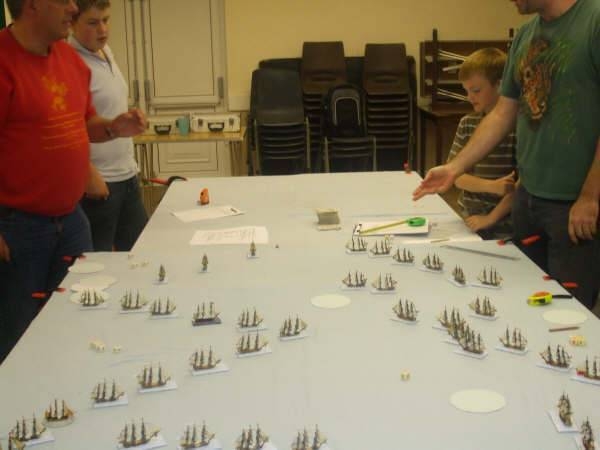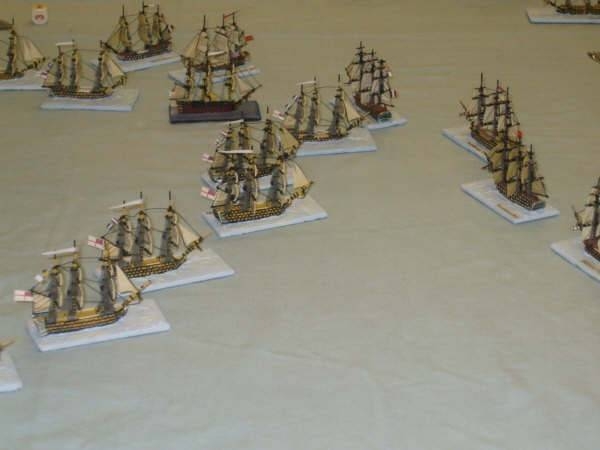 |
ENGLAND EXPECTS
“But Unfortunately Didn’t Get” It was Saturday the 27th September when the club re-fought the Battle of Cape Trafalgar, with the allied combined fleets under Villeneuve (Keith) already set up on table with the relevant Van, Centre and Rear in as a historical deployment as the 9 x 5ft table would allow. It was up to the English C-in-C to decide his deployment and battle plan using the ships available to Nelson on the fateful day back in 1805. |
|
David who was the English C & C chose to attack in a four column formation. Given the size of the allied fleet and working on the premise that at least one or two columns would break the combined line and cause a pell-mell battle of annihilation, this seemed a reasonable plan. |
 |
With the 100 gun Britannia leading the weather column, supported by the Orion, Minotaur, Spartiate and two 64 gun vessels this was the first column to try and break the line at the allied Van.
|
| the Van with the Mont-Blanc and the Formidable getting the better of this column with the Orion, Minotaur, Spartiate and the Africa all taking heavy hull damage. The Van also took heavy damage to the hulls and masts of Mont-Blanc and the Spanish San-Francisco De Asia. But the cost of the four above named English vessels sinking or limping away from the battle removed any threat from the first column.
By now the second column led by the Victory had also come into long range and was not doing any better. At the end of turn four the Ajax had lost a mast to a heavy pounding from the Santisima-Trinidad who being armed with 140 guns and even with poor quality crews was doing enough hits to damage her targets. When the Bucentaure, the Redoutable and Heros also got the range the Victory lost a mast, along with the Neptune, the Leviathan and the Temeraire; the latter also loosing her Captain to a round shot. By turn six the chances of this column even reaching the combined fleet looked to be very slim. The card system the club used to regulate hits was working in the combined fleet’s favour with nearly one British vessel from each column taking damage to either hulls or masts per turn.
The only real success for the English at game turn six was the last column lead by the Royal Sovereign who had turned and fought the allied line in the old style of fighting (line to line) and where the elite battle-hardened English showed their true colours. With only the loss of a mast to the Swiftsure, this column inflicted enough damage on the Rear Squadron of the allied fleet to sink the Bahama and the Algesiras and set the Aigle alight. By game turn eight and with failing light (10 pm local time) the English C-in-C had decided that the historical victory achieved by Nelson was not on the cards and he ordered his remaining vessels to cover the withdrawal from Cape Trafalgar of what was left of his fleet. This put the fourth column under Collingwood (Mike) as the last line of defence to cover the withdrawal of his other three columns. Any vessel not able to make sail was ordered to be taken in tow by the four frigates Nelson had kept out of the battle for this very purpose. It just remains to be seen if Collingwood is up to the job of covering the withdrawal but this is for another high seas action game at a later date.
For more photos see the Photo Gallery. This just left the last two English columns to try and breach the allied Centre and Rear with both columns taking the same punishment that the first two columns were taking with the Achille and the Revenge along with the Prince in the third column all loosing masts, with only the capture of the French vessel Fougueux for any gain, which was then fired on by the Santa-Anna when they realised that the Fougueux had been captured. |
 |
Have you heard the latest report on dish television? You can get satellite television for really cheap these days with all the great satellite tv offers that are floating around. Sign up for satellite tv service today for cheap!





